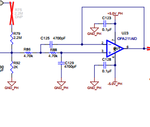AssemblyLine
Member level 1
I am working on 3 phaseAC machine inverter.
For measuring the motor phase voltages I use the following circuit

In my project the op-amps supply voltage is +/-5VDC; the inverter module supply voltage is +15VDC. These power supplies are deried from an isolated +5VDC supply. So the op-amps and the inverter module (which contains the power igbts) are not isolated one from each other. The GND_PH from the above picture is connected to the DC intermediary stage of the inverter.
In the scenario in which one of the resistor from the voltage divider would fail open ( R76, R87, R94) I would have very high voltages to the op-amp inputs (U22). Those bidirectional diodes (D37, D38) are there to prevent that, by clamping those high voltages to about 2-6 V (from diodes 's datasheet).

Question :
1.If i want to use the configuration in which unipolar voltage is sensed (by using R75 and just the OPA211), in order to have overvoltage protection should I put those diodes like that? Also should I put those diodes on the GND line too?
2. What would be the errors introduced by those diodes in the signal I want to measure? All I could think is the leakage current of diodes. But I don't know how that would affect the divided voltage
3. If I want to use varistors instead of TVS what would be the errors introduced?
For measuring the motor phase voltages I use the following circuit
In my project the op-amps supply voltage is +/-5VDC; the inverter module supply voltage is +15VDC. These power supplies are deried from an isolated +5VDC supply. So the op-amps and the inverter module (which contains the power igbts) are not isolated one from each other. The GND_PH from the above picture is connected to the DC intermediary stage of the inverter.
In the scenario in which one of the resistor from the voltage divider would fail open ( R76, R87, R94) I would have very high voltages to the op-amp inputs (U22). Those bidirectional diodes (D37, D38) are there to prevent that, by clamping those high voltages to about 2-6 V (from diodes 's datasheet).
Question :
1.If i want to use the configuration in which unipolar voltage is sensed (by using R75 and just the OPA211), in order to have overvoltage protection should I put those diodes like that? Also should I put those diodes on the GND line too?
2. What would be the errors introduced by those diodes in the signal I want to measure? All I could think is the leakage current of diodes. But I don't know how that would affect the divided voltage
3. If I want to use varistors instead of TVS what would be the errors introduced?
Last edited:

